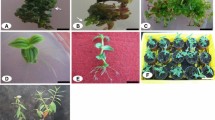Abstract
Mesembryanthemum crystallinum plants have been regenerated via organogenesis from hypocotyl, cotyledonary node, and leaf expiants with varying frequencies. The highest regeneration frequencies were obtained from either hypocotyls (23–34%) or cotyledonary nodes (21–41%). Leaf expiants yielded very poor regeneration frequencies (0–11%). Expiants were placed on Murashige and Skoog (MS) media supplemented with 3% sucrose, 0.8% bacto-agar and either, 10.8×10−6M NAA and 8.8×10−6M BA (MSmsh), 1×10−5M BA and 1×10−6M IAA, (MS4) or 1×10−6M BA and 1×10−6M IAA (MS5). Shoot formation frequencies were greater on MS4 and MS5 and lower on MSmsh, however, overall differences of regeneration frequency among media tested were not statistically significant. Regenerated plantlets were rooted on MS medium without growth regulators. Mature, regenerated plants were fertile and exhibited DNA content and ploidy profiles that were identical to wild type plants.
Similar content being viewed by others
Abbreviations
- MS:
-
Murashige and Skoog media
- CAM:
-
Crassulacean acid metabolism
- kbp:
-
kilobase pairs
- NAA:
-
1-naphthaleneacetic acid
- BA:
-
6-benzyladenine
- IAA:
-
indole-3-acetic acid
References
Bohnert HJ, JA Ostrem, JC Cushman, CB Michalowski, J Rickers, G Meyer, EJ DeRocher, DM Vernon, M Krueger, L Vazquez-Moreno, J Velten, R Höfner, JM Schmitt (1988) Mesembryanthemum crystallinum, a higher plant model for the study of environmentally induced changes in gene expression. Plant Mol Biol Rep 6:10–28.
Cox DR (1970) Analysis of binary data. Chapman and Hall, New York. pp. 142.
Cushman JC, G Meyer, CB Michalowski, JM Schmitt, HJ Bohnert (1989) Salt stress leads to differential expression of two isogenes of phosphoenolpyruvate carboxylase during CAM induction in the Common Ice Plant. Plant Cell 1:715–725.
DeRocher EJ, KR Harkins, DW Galbraith, HJ Bohnert (1990) Developmentally regulated systemic endopolyploidy in succulents with small genomes. Science 250:99–101.
Hoagland DR and DI Arnon (1938) The water culture method for growing plants without soil. UC College of Agriculture, Ag.Exp. Station, Berkeley, CA. Circular 347, pp. 1–39.
Michalowski CB, Olson SW, Piepenbrock M, Schmitt JM, Bohnert HJ 1989. Time course of mRNA induction elicited by salt stress in the common ice Plant (Mesembryanthemum crystallinum). Plant Physiol 89:811–816
Murashige T and F Skoog (1962) A revised medium for rapid growth and bioassays with tobacco tissue cultures. Physiol Plant 15:473–479.
Ostrem JA, Vernon DM, Bohnert HJ (1990) Increased expression of a gene coding for NAD: Glyceraldehyde-3-phosphate dehydrogenase during the transition from C3 photosynthesis to Crassulacean acid metabolism in Mesembryanthemum crystallinum. J Biol Chem 265:3497–3502.
Ting IP (1985) Crassulacean acid metabolism. Ann. Rev. Plant Physiol. 36:595–622.
Author information
Authors and Affiliations
Additional information
Communicated by J.M. Widholm
Rights and permissions
About this article
Cite this article
Meiners, M.S., Thomas, J.C., Bohnert, H.J. et al. Regeneration of multiple shoots and plants from Mesembryanthemum crystallinum . Plant Cell Reports 9, 563–566 (1991). https://doi.org/10.1007/BF00232332
Received:
Revised:
Issue Date:
DOI: https://doi.org/10.1007/BF00232332




